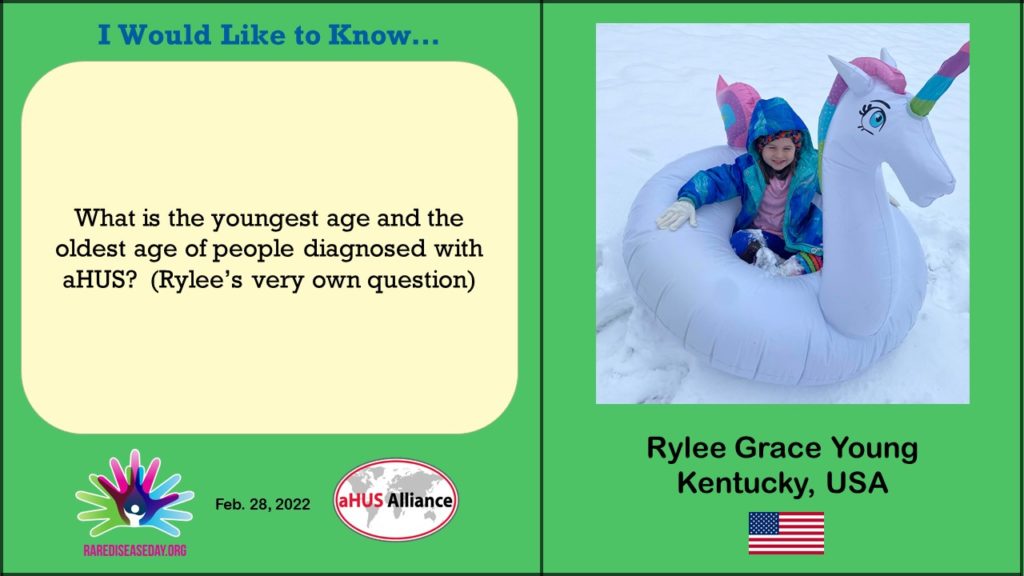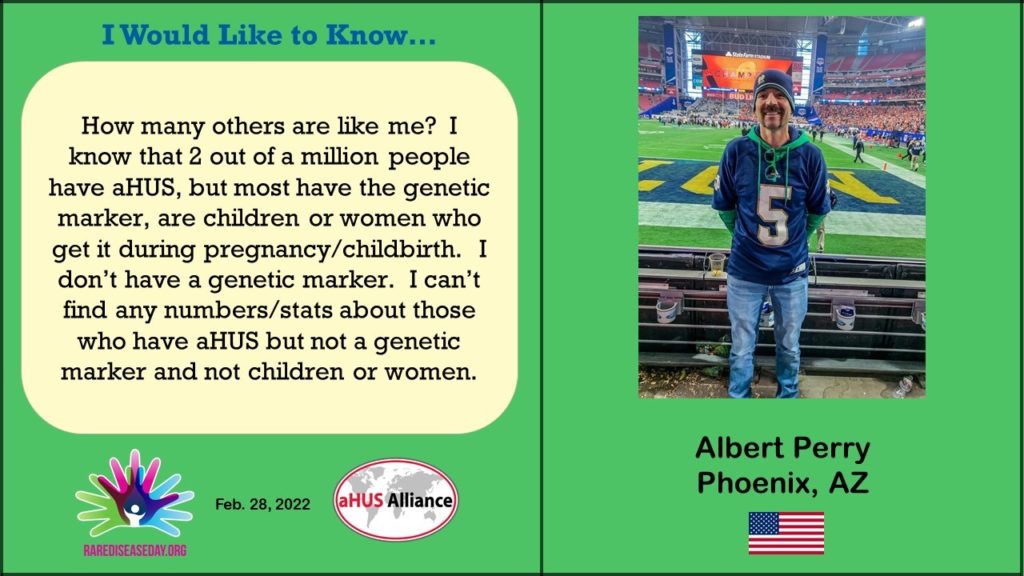Let us kick off the responses to the RDD2022 Video with a couple of questions about the characteristics of aHUS patients.
I may have written in the past that if all aHUS patients were put into a hat, and one was chosen at random, the patient that emerged would most likely be a woman , white, around 30 years old, genetically susceptible to aHUS, and her aHUS would have been triggered by pregnancy. All based on averages and probabilities.
But the reality is that no one knows how many aHUS patients there are let alone what they most likely look like.
All patient characteristics information is incomplete. Appearances will change with time, place and in different samples or “cohorts” of patients included in studies of aHUS .
In Global Action’s recent study of the aHUS diagnosis process, in which 227 aHUS patients participated, the characteristics of the participants were shown in Appendix A. ( *see copy at end of this page) It has percentages for age and gender and more and, although the actual figures differed, we found that the 227 fell within the range of those reported earlier in other “global” studies and polls.
The same pattern was found , there were twice as many adult patients than children; there were two female patients for every male. In childhood there were slightly more boys than girls but when children get older boys and girls are similar in number. There were far more adult female patients than male patients.
One other observation we made was that in later aHUS onsets ( i.e. over 55 years old ) there were 20 women and only two men! In a large database of USA hospital eculizumab treated patients, which Global Action reported on 1 in 6 of them were over 65 years of age.
aHUS patients in their 80s have appeared in research reports. Some of those patients could now be in their mid 80s to nearly 90 years old.There is no upper limit to the age of that aHUS patients can reach , Rylee Grace. Normal life spans can be expected for those treated well.
Also babies are born with a Complement system and some could have inherited a defect making them immediately susceptible to aHUS. And so aHUS can happen to them too. A few years ago there was a story about a five week old baby having aHUS. Maybe that baby was the youngest then. (Click HERE to see a video of the story)

So when it comes to describing aHUS patients characteristics there are no exact statistics.
Same with estimates of patient numbers, care needs to be taken using them. First there is a difference between prevalence of aHUS and incidence of aHUS rates( usually expressed as number per million of the population) .
Prevalence rates estimate how many patient are living, having had aHUS. Incidence rate is how many are likely to onset with aHUS in a year.
Depending on the rates used there could between 16000 and 79000 people in the world alive having had aHUS. Quite a spread of estimates. Similarly there could be between 2000 and 20,000 patients onsetting with aHUS each year. Global Action is more prudent in its estimates and consider that patient numbers are around 24000 alive and 4000 needing diagnosis each year. Very small numbers in a world of 8 billion people!
There are more than 2 per million people with aHUS in the USA , the prevalence rate is likely to be 6. In which case there are 2000 ,or so, American aHUS patients. Around 2 in 3 of them are adults , roughly 1300.
About a fifth of adults , 260, are men.
Usual estimates of patients who are found to have no identifiable genetic cause ( or idiopathic as doctors call it ) for their aHUS, yet, are around 40% of all patients. That would mean about 100 adult male aHUS patients in the USA with no known genetic cause found.
In the Global Action study, only 18% of male patients reported no genetic cause known. If that percentage was used to produce an “idiopathic” estimate, the result would be around 50 USA male patients. So it is likely that between 1 in 20 and 1 in 40 USA aHUS patients are both male and idiopathic .

With a population of around 1.6 million there are possibly 10 aHUS patients living in Phoenix, Albert.
You are one of those 10, Albert and are likely to be the only one in Phoenix without a known genetic marker.
* Extracted from “aHUS Diagnosis Process: Patients’ experience of specialist care and the diagnosis decision.” which can be seen in full on this website in the article “You’ve Got aHUS”
Appendix A Characteristics of patients participating
| Infants | Older children | All under 18 | All 18 and over | All | |||||||
| No . | % | No. | % | No. | % | No, | % | No | % | ||
| Age ( years) : | |||||||||||
| 0 to 18 | 36 | 16 | 42 | 18 | 78 | 34 | – | – | 78 | 34 | |
| 18 to 54 | – | – | – | – | – | – | 127 | 56 | 127 | 56 | |
| Fifty-five and over | 22 | 10 | 22 | 10 | |||||||
| Total | 36 | 16 | 42 | 18 | 78 | 34 | 149 | 66 | 149 | 100 | |
| Gender: | |||||||||||
| Female | 16 | 7 | 21 | 9 | 37 | 16 | 119 | 53 | 156 | 69 | |
| Male | 20 | 9 | 20 | 9 | 40 | 18 | 29 | 12 | 69 | 30 | |
| Other | – | – | 1 | 0.5 | 1 | 0.5 | 1 | 0.5 | 2 | 1 | |
| Regional territory: | |||||||||||
| N. America | 20 | 9 | 20 | 9 | 40 | 18 | 103 | 45 | 143 | 63 | |
| Europe | 6 | 3 | 15 | 7 | 21 | 9 | 37 | 17 | 58 | 26 | |
| Rest of World* | 10 | 4 | 7 | 3 | 17 | 7 | 9 | 4 | 26 | 11 | |
| Lifestyle: | |||||||||||
| Infant | 36 | 16 | – | – | 36 | 16 | – | – | 36 | 16 | |
| Studying | – | – | 42 | 18 | 42 | 18 | 21 | 10 | 63 | 28 | |
| Working | – | – | – | – | – | – | 107 | 47 | 107 | 47 | |
| Retired | – | – | – | – | – | – | 10 | 4 | 10 | 4 | |
| Other** | – | – | – | – | – | – | 11 | 5 | 11 | 5 | |
| Diagnosed: | |||||||||||
| Pre-2011 | 10 | 4 | 8 | 3 | 18 | 7 | 18 | 7 | 36 | 14 | |
| 2011-2015 | 6 | 3 | 11 | 4 | 17 | 7 | 44 | 21 | 61 | 28 | |
| Post-2015 | 20 | 9 | 23 | 11 | 43 | 20 | 87 | 38 | 130 | 58 | |
| Family History: | |||||||||||
| aHUS known | 4 | 2 | 1 | 0.5 | 5 | 2.5 | 7 | 2.5 | 12 | 5 | |
| aHUS not known | 1 | 0.5 | 2 | 1 | 3 | 1.5 | 6 | 2.5 | 9 | 4 | |
| No history | 31 | 13.5 | 39 | 16.5 | 70 | 30 | 136 | 61 | 206 | 91 | |
| Kidney disease known | 6 | 3 | 4 | 2 | 10 | 5 | 30 | 13 | 40 | 18 | |
| Kidney disease not known | 2 | 1 | 2 | 1 | 4 | 2 | 5 | 2 | 9 | 4 | |
| No history | 28 | 12 | 36 | 15 | 64 | 27 | 114 | 51 | 178 | 78 | |
| Genetic variant *** | |||||||||||
| All Yes | 32 | 14 | 35 | 15 | 67 | 29 | 101 | 45 | 168 | 74 | |
| All No | 3 | 1 | 7 | 3 | 10 | 5 | 48 | 21 | 58 | 26 | |
| Overall +ve % | 91 | – | 83 | – | 87 | – | 68 | – | 74 | ||
| By Gender | |||||||||||
| Female -Yes | 14 | 6 | 16 | 7 | 30 | 13 | 76 | 34 | 106 | 47 | |
| Female- No | 1 | 0.5 | 5 | 2 | 6 | 2 | 43 | 20 | 49 | 22 | |
| Female +ve % | 93 | – | 71 | – | 83 | – | 64 | – | 68 | ||
| Male -Yes | 18 | 8 | 18 | 8 | 36 | 16 | 24 | 10 | 60 | 26 | |
| Male – No | 2 | 1 | 2 | 1 | 4 | 2 | 5 | 2 | 9 | 4 | |
| Male +ve %: | 90 | – | 90 | – | 90 | – | 82 | – | 87 | ||
| Other Yes | – | – | 1 | – | 1 | – | 1 | – | 2 | 1 | |
| Other +ve % | – | – | 100 | – | 100 | – | 100 | – | 100 |
*Africa-2, Asia-10, Oceania-12, South America-2 ** homemaker-2 ill-2 maternity-5 unemployed-2
*** 1 no response
Article No. 488

